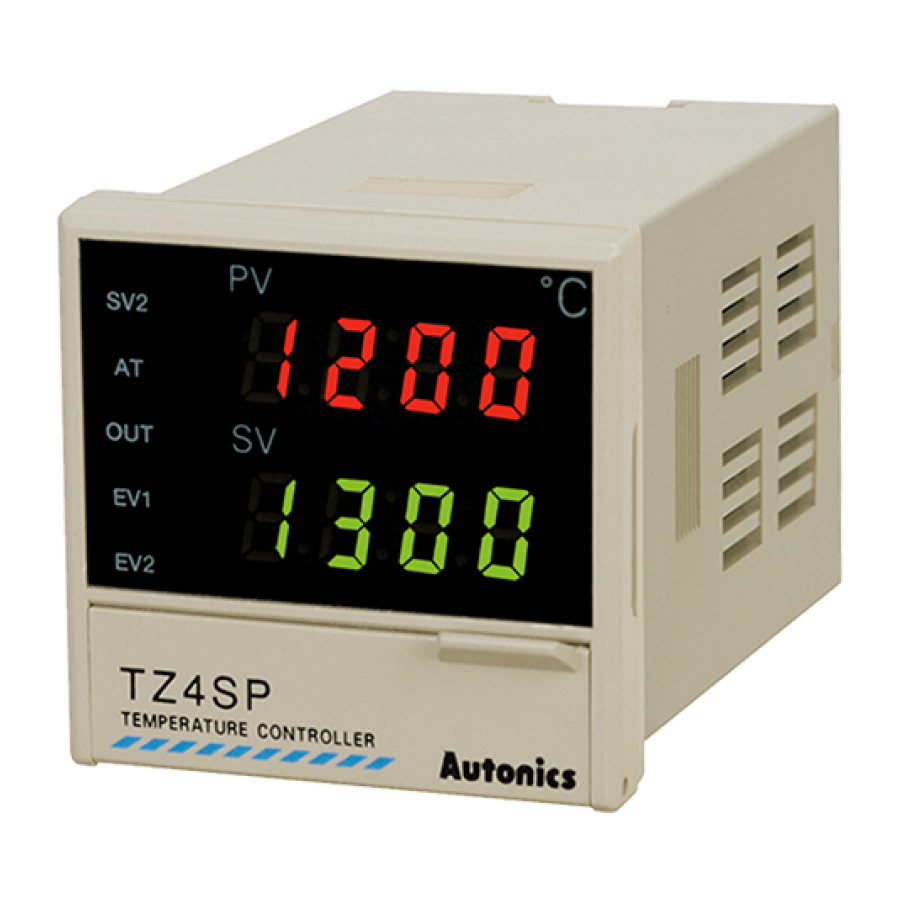Autonics TZN4M Manuel - Page 12
Parcourez en ligne ou téléchargez le pdf Manuel pour {nom_de_la_catégorie} Autonics TZN4M. Autonics TZN4M 17 pages. Dual pid control temperature controller
Également pour Autonics TZN4M : Manuel (4 pages), Manuel d'instruction (2 pages), Manuel (16 pages), Manuel (16 pages), Manuel (17 pages)

ON/OFF control
ON/OFF control is called two position control because
the output turns on when PV falls lower than SV and the
output turns off when PV is higher than SV.
This control method is not only for controlling temperature,
but also it is basic control method for sequence control.
● If you set value P as )0 in parameter 1 group, ON/OFF
control will operate.
● There is a programmable temperature difference
between ON and OFF in ON/OFF control, if difference
is too small, then hunting(chattering) can occur.
● Temperature difference can be set in HYS mode of
parameter 1 group. Setting range is 1 to 100(or 0.1 to
100.0).
● HYS mode is displayed when P value is )0 , but HYS will
not be displayed, and then jump if P value is not )0 .
● This ON/OFF control should not be applied when
equipment(cooling compressor) to be controlled can be
damaged by frequent ON and OFF.
● Even if ON/OFF control is stable status, the hunting can
be occurred by setting value in HYS or capacity of the
heater or response characteristic of the equipment to
be controlled or installing position of the sensor. Please
consider above points to minimize the hunting when
designing the system.
Manual reset [ REST ]
Proportional control has deviation because rising time is
not same as falling time, even if the unit operates normally.
Manual reset function is used at proportional control mode
only.
● If set REST function in parameter 1 group, the manual
reset will run.
● When PV and SV is equal, REST value is 50.0% and
when control is stable, if the temperature is lower than
SV, REST value should be higher and on the other hand,
REST value should be smaller.
● REST setting method according to result of control.
Setting
value
(SV)
Process
value(PV)
Decimal point setting [ DOT ]
Decimal point is displayed as DOT in parameter 2 group when
the input is analog only.(0-10VDC, 1-5VDC, DC4-20mA)
Dual PID Auto Tuning Control
Decrease reset
Normal deviation
Normal deviation
Increase reset
Dual PID control
When controlling temperature, two types of control
characteristic are available as below.
One is when you need to minimize the time which PV
reaches to SV as like(Fig. 1). The other is when you need
to minimize overshoot even though the reaching time(PV
to SV) is slow(Fig. 2).
● There are high-speed response type and low-speed
response type built in this unit. Therefore user can select
each function according to their application.
● You can select dual PID control function in parameter 2
group. It is selectable PIdF or PIdS in PIDT mode.
PIdF (high-speed response type)
This mode is applied to machines or systems which
require high-speed response.
(Fig. 1)
PV
S
SV
t
PIdF
PIdS (low-speed response type)
It is PID Slow, used to minimize overshoot even though
the response is slow. For control temperature of oil,
plating machine have a possibility of fire with overshoot,
PIdS (limit over) should be used.
(Fig. 2)
SV
PV
t
※ Factory default setting is PIdS .
Please select mode according to control system.
RS485 communication
It is used on the purpose that transmitting PV to an external
equipment, setting SV at the external equipment.
● It can be set at BPS , ADRS in second parameter 2 group.
● Communication speed[ BPS] set range: 2400, 4800,
9600bps
● Start bit(1bit, fixed), Stop bit(1bit, fixed), Parity bit(none)
● Communication address[ ADRS] set range: 1 to 99
Communication converters (sold separately)
SCM-38I(RS-232C to RS485 converter)
SCM-US48I(USB to RS485 converter)
SCM-WF48(Wi-Fi to RS485/USB communication
converter(available soon)
※ t : Reaching time
S : Overshoot
SV: Setting value
PV: Process value
※ t : Reaching time
SV: Setting value
PV: Process value
PIdS
H-83
(A)
Photo
electric
sensor
(B)
Fiber
optic
sensor
(C)
Door/Area
sensor
(D)
Proximity
sensor
(E)
Pressure
sensor
(F)
Rotary
encoder
(G)
Connector/
Socket
(H)
Temp.
controller
(I)
SSR/
Power
controller
(J)
Counter
(K)
Timer
(L)
Panel
meter
(M)
Tacho/
Speed/ Pulse
meter
(N)
Display
unit
(O)
Sensor
controller
(P)
Switching
mode power
supply
(Q)
Stepper
motor&
Driver&Controller
(R)
Graphic/
Logic
panel
(S)
Field
network
device
(T)
Software
(U)
Other
